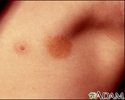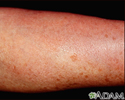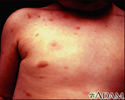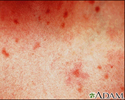Urticaria pigmentosa
Mastocytosis; Maculopapular cutaneous mastocytosis; Diffuse cutaneous mastocystosis
Urticaria pigmentosa is a skin disease that produces patches of darker skin and very bad itching. Hives can develop when these skin areas are rubbed.
Causes
Urticaria pigmentosa occurs when there are too many inflammatory cells (mast cells) in the skin. Mast cells are immune system cells that help the body fight infections. Mast cells make and release histamine, which causes nearby tissues to become swollen and inflamed.
Things that can trigger histamine release and skin symptoms include:
- Rubbing the skin
- Infections
- Exercise
- Drinking hot liquids, eating spicy food
- Temperature changes, such as heat or cold
- Stress or anxiety
- Medicines, such as aspirin or other NSAIDs, codeine, morphine, x-ray dye, some anesthesia medicines, and alcohol
Urticaria pigmentosa is most common in children. It can also occur in adults.
Symptoms
The main symptom is brownish patches on the skin. These patches contain cells called mastocytes. When mastocytes release the chemical histamine, the patches develop into hive-like bumps. Younger children may develop a blister that is filled with fluid if the bump is scratched.
The face may also get red quickly.
In severe cases, these symptoms may occur:
- Diarrhea
- Fainting (uncommon)
- Headache
- Wheeze
- Rapid heartbeat
- Abdominal pain
Exams and Tests
The health care provider will examine the skin. The provider may suspect urticarial pigmentosa when the skin patches are rubbed and raised bumps (hives) develop. This is called the Darier sign.
Tests to check for this condition are:
- Skin biopsy to look for a higher number of mast cells
- Imaging or lab tests if symptoms other than rash are present
- Blood tests for blood cell counts and blood tryptase levels (tryptase is an enzyme found in mast cells)
- Bone marrow biopsy may be recommended in adults
Treatment
Avoid histamine release triggers.Triggers include insect bites and stings, exposure to temperature extremes, certain medicines, and rubbing the skin lesions.
Antihistamine medicines can help relieve symptoms such as itching and flushing. Talk to your provider about which type of antihistamine to use. Corticosteroids applied on the skin and light therapy can also be used in some cases.
Your provider may prescribe other kinds of medicine to treat symptoms of severe and unusual forms of urticaria pigmentosa.
Outlook (Prognosis)
Urticaria pigmentosa goes away by puberty in about one half of affected children. Symptoms usually get better in others as they grow into adulthood.
In adults, urticaria pigmentosa can lead to systemic mastocytosis. This is a serious condition that can affect bones, the brain, nerves, and the digestive system.
Possible Complications
The main problems are discomfort from itching and concern about the appearance of the spots. Other problems such as diarrhea and fainting are rare.
Insect stings may also cause a bad allergic reaction in people with urticaria pigmentosa. Ask your provider if you should carry an epinephrine kit to use if you get a bee sting.
When to Contact a Medical Professional
Contact your provider if you notice symptoms of urticaria pigmentosa.
References
Dinulos JGH. Urticaria, angioedema, and pruritus. In: Dinulos JGH, ed. Habif's Clinical Dermatology. 7th ed. Philadelphia, PA: Elsevier; 2021:chap 6.
George TI, Sotlar K, Valent P, Horny H-P. Mastocytosis. In: Jaffe ES, Arber DA, Campo E, Harris NL, Quintanilla-Martinez L, eds. Hematopathology. 2nd ed. Philadelphia, PA: Elsevier; 2017:chap 49.
Wakelin SH. Dermatology. In: Feather A, Randall D, Waterhouse M, eds. Kumar and Clarke's Clinical Medicine. 10th ed. Philadelphia, PA: Elsevier Limited; 2021:chap 22.
Urticaria pigmentosa in the armpit - illustration
Urticaria pigmentosa in the armpit
illustration
Mastocytosis - diffuse cutaneous - illustration
Mastocytosis - diffuse cutaneous
illustration
Urticaria pigmentosa on the chest - illustration
Urticaria pigmentosa on the chest
illustration
Urticaria pigmentosa - close-up - illustration
Urticaria pigmentosa - close-up
illustration
Review Date: 11/30/2022










